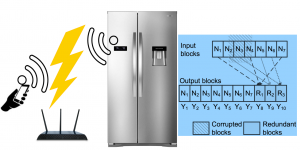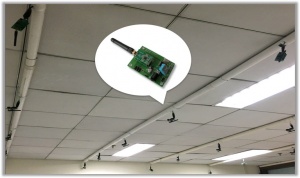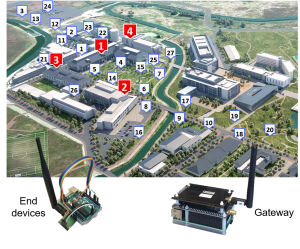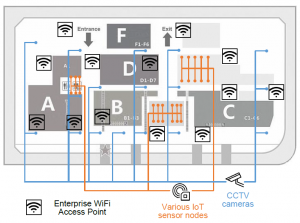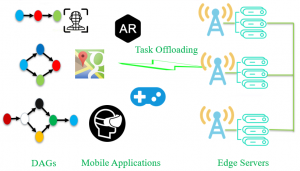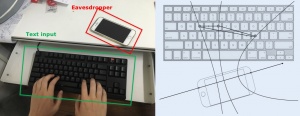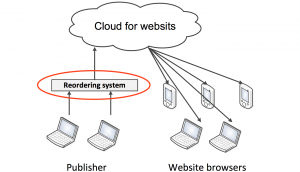Difference between revisions of "Research"
(→项目支持) |
|||
| Line 46: | Line 46: | ||
minimizing the number of edge nodes and providing real-time processing service for the IoT network. | minimizing the number of edge nodes and providing real-time processing service for the IoT network. | ||
Publications: [http://mobinets.org/research/edgedeploy/edgedeploy.pdf | Publications: [http://mobinets.org/research/edgedeploy/edgedeploy.pdf Static deployment] | ||
[https://ieeexplore.ieee.org/document/9375469/ 5G/6G mobile deployment] | |||
[https://github.com/mobinets/6G-Edge-Computing-Simulation-Deployment code] | |||
| style="width: 30%"|[[File:edgedeploy.png|thumb|link=]] | | style="width: 30%"|[[File:edgedeploy.png|thumb|link=]] | ||
|- | |- | ||
| Line 53: | Line 55: | ||
Driven by the tremendous application demands, mobile devices are expected to fulfill computation-intensive and latency-sensitive tasks, which pose a significant challenge for mobile devices with the limited computational ability and battery capacity. To address this problem, we investigate the problem of fine-grained task offloading in edge computing systems. By explicitly considering 1) the topology/schedules of the IoT tasks, 2) the heterogeneous resources on edge servers and 3) the wireless interference in the multi-access edge networks, we propose a lightweight yet efficient offloading scheme for multi-user Edge systems, which offloads the most appropriate tasks/subtasks to edge servers such that the expected execution time is minimized. | Driven by the tremendous application demands, mobile devices are expected to fulfill computation-intensive and latency-sensitive tasks, which pose a significant challenge for mobile devices with the limited computational ability and battery capacity. To address this problem, we investigate the problem of fine-grained task offloading in edge computing systems. By explicitly considering 1) the topology/schedules of the IoT tasks, 2) the heterogeneous resources on edge servers and 3) the wireless interference in the multi-access edge networks, we propose a lightweight yet efficient offloading scheme for multi-user Edge systems, which offloads the most appropriate tasks/subtasks to edge servers such that the expected execution time is minimized. | ||
Publications:[https://ieeexplore.ieee.org/abstract/document/8847369 IoTJ] | Publications:[https://ieeexplore.ieee.org/abstract/document/8847369 IoTJ] [https://github.com/mobinets/task-offloading-edge-computing code] | ||
| style="width: 30%"|[[File:edgeoffload.png|thumb|link=]] | | style="width: 30%"|[[File:edgeoffload.png|thumb|link=]] | ||
|- | |- | ||
Revision as of 21:04, 27 November 2021
Our research works are driven by the emergence of pervasive IoT systems and 5G technologies. With the aid of low-power networks and edge computing, we believe that IoT will soon become part of our daily life and change humans' life style. Motivated by this expectation, our research interests lie in low-power wireless networks, edge computing, and mobile/wearable computing.
Low-power IoT
In Low-power IoT, we focus on the key enabling technologies for IoT, such as ZigBee and LoRa networks. Specific topics include ad hoc protocols, performance modeling, bulk data transfer, network coding, etc.
| ZiXOR: Lightweight network coding for reliable communications in IoT.
Indoor IoT communications (ZigBee, BlueTooth) usually suffer from the inference from WiFi networks. We devise a lightweight yet reliable network coding system for indoor IoT communications, which incurs minimized redundancy and does not require change on the off-the-shelf devices. The system is implemented with TelosB/TinyOS nodes and significantly improves the reliability of indoor IoT applications. The erratum for the publication is here. |
|
| BDTrans: Big data transfer in low power wireless.
The wireless applications are becoming more and more data-intensive, leading to a massive requirement on big data transfer such as video data, software update, etc. We devise two general building blocks for big data transfer in LP wireless networks. 1) Accurate sender selection: the most efficient network nodes are selected for data transfer. 2) Fast data transmission protocol: an energy-efficient transmission protocol specifically designed for transferring big data. With the modules, energy efficiency and transmission reliability are significantly improved. |
|
| Energy fairness in LoRa networks.
LoRa is a technology of Low-Power Wide-Area Networks. Based on the Chirp Spread Spectrum, LoRa end devices can modify spreading factor (SF) to achieve different communication ranges and data rates, leading to energy consumption unfairness on end-devices and affecting the network lifetime. We propose two methods to improve the energy fairness in LoRa networks and prolong the network lifetime. 1) Static fairness: Model the relationship between energy fairness and resource allocation, and solve an optimization problem to fairly allocate the resources. 2) Dynamic fairness: Considering the unstable wireless link condition, we update the resource allocation to adapt to the dynamic LoRa networks. |
Edge computing
Edge computing plays an important role in supporting the massive IoT computation/communication demands. In edge computing, we focus on network deployment, resource allocation, protocols, etc. Video for our Low-cost Edge-AI System project.
| Edge Deployment for IoT.
To support real-time processing for large scale IoT, deploying edge nodes with communication, storage, and computational capability is a promising approach. The deployment of edge nodes is an important and key problem. In this paper, we carefully analyze the impacting factors in IoT environments and identified the key challenges for edge node deployment. We then propose a novel three-phase deployment approach which considers both the IoT node diversity and the environmental wireless diversity. The proposed work aims at minimizing the number of edge nodes and providing real-time processing service for the IoT network. Publications: Static deployment 5G/6G mobile deployment code |
|
| Computation offloading in Edge-IoT networks.
Driven by the tremendous application demands, mobile devices are expected to fulfill computation-intensive and latency-sensitive tasks, which pose a significant challenge for mobile devices with the limited computational ability and battery capacity. To address this problem, we investigate the problem of fine-grained task offloading in edge computing systems. By explicitly considering 1) the topology/schedules of the IoT tasks, 2) the heterogeneous resources on edge servers and 3) the wireless interference in the multi-access edge networks, we propose a lightweight yet efficient offloading scheme for multi-user Edge systems, which offloads the most appropriate tasks/subtasks to edge servers such that the expected execution time is minimized. |
|
| User Aware Content Caching for Mobile Edge Computing.
Mobile Edge Computing (MEC) provides storage, access and computing opportunities for resource-constrained mobile users. In this project, we propose a content caching scheme specifically designed for mobile multimedia users. The mobile users are characterized using the sensory data. Then the potential interest data are predicted according to our prediction of the user preferences. |
Mobile/wearable computing
| PoKeMon: Position free keystroke monitoring with smartphones.
Smartphones nowadays are highly capable to sense various real-world environmental data. In this project, we use a single smartphone to measure the acoustic signals of the keystrokes from keyboard users, which in turn are used to recognize the specific tapped keys. Potential application scenarios include virtual keyboard (you can draw your own keyboard and it works!) and eavesdropping user input. |
|
| R-Render: Enhancing web QoE with optimized rendering.
Modern websites pose serious challenges to high-QoE web browsing due to the webpage complexity. In this project, an optimization proxy is devised, in which all webpage elements are re-ordered according to their QoE contributions and the used browsers. As a result, the webpage elements are placed in the best positions for specific browsers and the user perceived browsing delay can be minimized. Publications:paper |
项目支持
Our research work is supported by a number of national foundations.
- 国家自然基金面上项目,边缘计算中网络功能虚拟化的用户体验质量与系统优化研究,2020.01~2023.12.
- 国家自然基金面上项目,面向城市物联网的边缘计算网络架构与关键技术研究,2020.01~2023.12.
- 国家重点研发计划子课题,面向IPv6的网络空间国际治理联合研发与示范,2020.01~2022.12.
- 隐私数据保护算法安全检测技术研究,2020.01-2021.12
- 国家博士后基金面上项目(一等),低功耗物联网中可靠高效的任务卸载技术研究,2019.01-2020.12
- 国家重点研发计划(子课题),众智网络建模与互联,2017.12-2020.11
- 国家博新人才计划项目,面向智慧城市的海量异构设备无线传输及组网研究,2017.09-2019.08
- 国家自然科学基金青年项目,低功耗无线网络中链路相关性的模型与协议优化研究,2016.01-2019.12
- 中央高校基础科研项目,面向智慧医疗的异构数据采集与处理关键技术研究,2018.01-2018.12
- 中央高校基础科研项目,无线传感网背景下链路相关性的模型及应用研究,2016.01-2017.12


